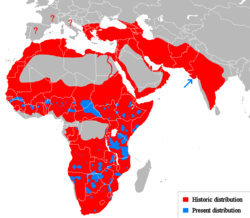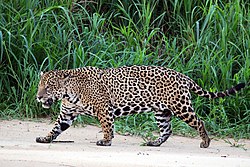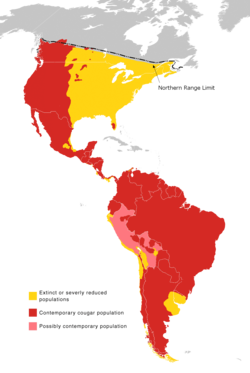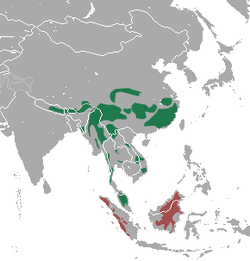List
Following list contains size (weight and length) measurements for wild adult males of each species:
| Rank | Common name | Scientific name | Image | Weight range kg (pounds) | Maximum weight kg (pounds) | Length range (m) | Maximum length (m) [a] | Shoulder height (cm) | Native range by continent(s) | Range map |
|---|---|---|---|---|---|---|---|---|---|---|
| 1 | Tiger | Panthera tigris |  | 126–221 [3] (277–487) | 317 (699) (Verified) [4] 387.8 (854) (Verified) [5] | 2.3–3.9 [6] | 4.0 [7] [8] | 70–110 [9] | Asia |  |
| 2 | Lion | Panthera leo |  | 160–195 [10] [11] (352–429) | 313 (690) (Verified); [12] [13] [14] 272 (600) (Unverified) [14] [b] | 2.7–3.5 [15] | 3.875 [13] | 90–135 [16] | Africa, Asia |  |
| 3 | Jaguar | Panthera onca |  | 56.1–104.5 [17] (123.6–230.3) | 148 (326) [18] | 1.8–2.7 [19] | 2.8 [20] | 68–80 [21] | North and South America |  |
| 4 | Cougar | Puma concolor |  | 53.1–71 [17] (117–156) | 105.2 (231) (Verified) [22] 125.2 (275) (Unverified) [23] | 1.5–2.4 [24] | 2.8 [25] | 53–88 [26] | North and South America |  |
| 5 | Leopard | Panthera pardus |  | 30–65.8 [27] [28] (66–143) | 108 (238) [29] | 1.6–2.3 [30] | 2.75 [31] [32] | 44–78 [33] | Africa, Europe and Asia |  |
| 6 | Cheetah | Acinonyx jubatus |  | 36.7–54.1 [34] [35] (80–119) | 69 (152) [36] | 1.5–2.3 [37] | 2.5 [38] [39] [40] | 77–94 [41] | Africa, Asia |  |
| 7 | Snow leopard | Panthera uncia |  | 30–39 [42] (66–85) | 53.8 (118) [43] | 1.6–2.1 [44] | 2.5 [45] [46] | 60–66 [47] | Asia |  |
| 8 | Clouded leopard | Neofelis nebulosa(diardi)? [c] |  | 16–23 [48] (35–50) | 26 (57) [48] | 1.2–1.6 [49] | 1.9 [50] | 46–56 [51] | Asia |  |
| 9 | Eurasian lynx | Lynx lynx |  | 17.4–21.7 [17] (38–47) | 45 (99) [52] | 0.8–1.3 [53] | 1.5 [54] [55] | 60–71 [56] | Asia, Europe |  |
| 10 | Bobcat | Lynx rufus |  | | | 6.4–18.3 (14–40) | 22.2 (49)(Verified) [57] 27 (59)(Unverified) [58] | 0.475–1.25 | 1.30 | 30–60 | North America |  |